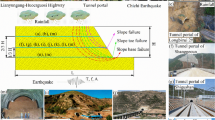Abstract
The Wenchuan earthquake of 12 May 2008 is the most destructive earthquake in China in the past 30 years in terms of property damage and human losses. In order to understand the earthquake process and the geo-morphological factors affecting the seismic hazard, we simulated the strong ground motion caused by the earthquake, incorporating three-dimensional (3D) earth structure, finite-fault rupture, and realistic surface topography. The simulated ground motions reveal that the fault rupture and basin structure control the overall pattern of the peak ground shaking. Large peak ground velocity (PGV) is distributed in two narrow areas: one with the largest PGV values is above the hanging wall of the fault and attributed to the locations of fault asperities and rupture directivity; the other is along the northwestern margin of the Sichuan Basin and caused by both the directivity of fault rupture and the amplification in the thick sediment basin. Rough topography above the rupture fault causes wave scattering, resulting in significantly larger peak ground motion on the apex of topographic relief than in the valley. Topography and scattering also reduce the wave energy in the forward direction of fault rupture but increase the PGV in other parts of the basin. These results suggest the need for a localized hazard assessment in places of rough topography that takes the topographic effects into account. Finally, had the earthquake started at the northeast end of the fault zone and ruptured to the southwest, Chengdu would have suffered a much stronger shaking than it experienced on 12 May, 2008.
Similar content being viewed by others
References
Zhang Y, Feng W P, Xu L S, et al. Temporal-spatial rupture process of M s8.0 Wenchuan earthquake of 2008. Sci China Ser D-Earth Sci, 2008, doi: 10.1007/s11430-008-0148-7
Graves R W. Preliminary analysis of long-period basin response in the Los Angeles region from the 1994 Northridge earthquake. Geophys Res Lett, 1995, 22: 101–104
Graves R W. Three-dimensional finite-difference modeling of the san Andreas fault: Source parameterization and ground-motion levels. Bull Seismol Soc Amer, 1998, 88: 881–897
Pitarka A, Irikura K, Iwata T, et al. Three-dimensional simulation of the near-fault ground motion fro the 1995 Hyogo-ken Nanbu (Kobe), Japan, Earthquake. Bull Seismol Soc Amer, 1998, 88(2): 428–440
Li Y, Densmore A L, Allen P A, et al. Sedimentary responses to thrusting and strike-slipping of Longmen Shan along eastern margin of Tibetan plateau, and their implication of Cimmerian continents and India/Eurasia collision. Sci Geol Sin, 2001, 10(4): 223–243
Burchfiel B C, Royden L H, van der Hilst R D, et al. A geological and geophysical context for the Wenchuan earthquake of 12 May 2008, Sichuan, People’s Republic of China. GSA Today, 2008, 18 (7), doi: 10.1130/GSATG18A.1
Frankel A, Vidale J. A three-dimensional simulation of seismic waves in the Santa Clara Valley, California, from a Loma Prieta aftershock. Bull Seismol Soc Amer, 1992, 82: 2045–2074
Olsen K B, Archuleta R J, Matarese J R. Three-dimensional simulation of a magnitude 7.75 earthquake on the San Andreas fault. Science, 1995, 270: 1628–1632
Sorensen M B, Atakan K, Pulido N. Simulated strong ground motions for the Great M9.3 Sumatra-Andaman earthquake of 26 December 2004. Bull Seismol Soc Amer, 2007, 97(1A): S139–S151
Lee S J, Chen H W, Huang B S. Simulations of strong ground motion and 3D amplification effect in the Taipei Basin by using a composite-grid finite-difference method. Bull Seismol Soc Amer, 2008, 98(3): 1229–1242
Zhang W, Chen X F. Traction image method for irregular free surface boundaries in finite difference seismic wave simulation. Geophys J Int, 2006, 167: 337–353
Zhang W. Finite-difference seismic wave modeling in 3D heterogeneous media with surface topography and its implementation in strong ground motion study. Dissertation for Doctoral Degree. Beijing: Peking University, 2006
Shapiro N M, Ritzwoller M H. Monte Carlo inversion for a global shear velocity model of the crust and upper mantle. Geophys J Int, 2002, 151: 88–105
Liang C, Song X, Huang J. Tomographic inversion of Pn traveltimes in China. J Geophys Res, 2004, 109, B11304, doi: 10.1029/2003JB002789
Zhu J, Cao J, Cai X, et al. High resolution surface wave tomography in east Asia and west Pacific marginal sea. Chin J Geophys, 2002, 45: 678–698
Huang Z, Su W, Peng Y, et al. Rayleigh wave tomography of China and adjacent regions. J Geophys Res, 2003, 108(B2): 2073, doi: 10.1029/2001JB001696
Lebedev S, Nolet G. Upper mantle beneath Southeast Asia from S velocity tomography. J Geophys Res, 2003, 108(B1): 2048, doi: 10.1029/2000JB000073
Sun Y, Toksöz M N. Crustal structure of China and surrounding regions from P wave traveltime tomography. J Geophys Res, 2006, 111, B03310, doi: 10.10292/2005JB003962
Bassin C, Laske G, Masters G. The current limits of resolution for surface wave tomography in North America. Eos Trans AGU, 2000, 81, F897
Laske G, Masters G. A global digital map of sediment thickness. Eos Trans AGU, 1997, 78, F483
Kennet B L N, Engdahl E R, Buland R. Constraints on seismic velocities in the Earth from traveltimes. Geophys J Int, 1995, 122: 108–124
Hixon R. On increasing the accuracy of MacCormack schemes for aeroacoustic applications. NASA Contractor Report 202311, 1996
Cerjan C, Kosloff D, Kosloff R, et al. A Nonreflecting boundary-condition for discrete acoustic and elastic wave-equations. Geophysics, 1985, 50: 705–708
Author information
Authors and Affiliations
Corresponding author
Additional information
Supported by the U.S. National Science Foundation (Grant Nos. EAR 0738779 and OCE 0727919), the National Basic Research Program of China (Grant No. 2004CB418404), and partially by the National Nature Science Foundation of China (Grant No. 40521002)
Rights and permissions
About this article
Cite this article
Zhang, W., Shen, Y. & Chen, X. Numerical simulation of strong ground motion for the M s8.0 Wenchuan earthquake of 12 May 2008. Sci. China Ser. D-Earth Sci. 51, 1673–1682 (2008). https://doi.org/10.1007/s11430-008-0130-4
Received:
Accepted:
Published:
Issue Date:
DOI: https://doi.org/10.1007/s11430-008-0130-4




